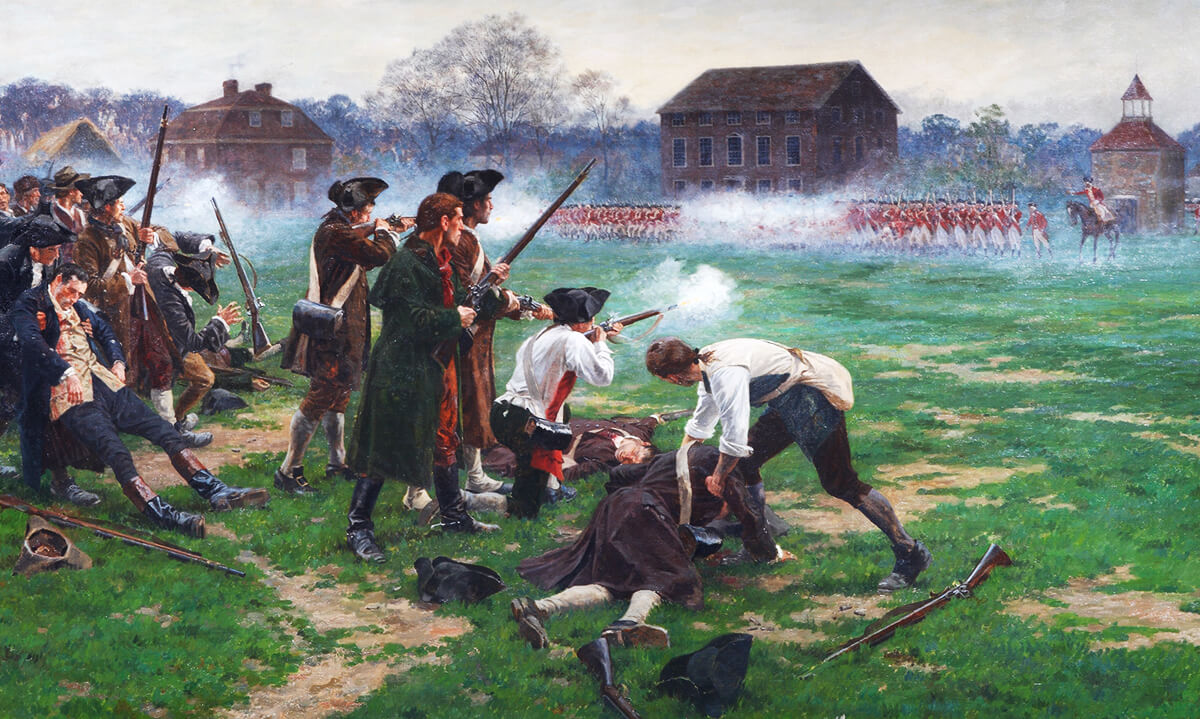The tradition of Thanksgiving as a time to focus on God and His blessings was introduced by European Americans and dates back well over four centuries in America.
For example, such thanksgivings occurred in:
- 1541 at Palo Duro Canyon, Texas with Coronado and 1,500 of his men1
- 1565 at St. Augustine, Florida with French Huguenot (Protestant) colonists2
- 1598 at El Paso, Texas with Juan de Oñate and his expedition3
- 1607 at Cape Henry, Virginia with the landing of the Jamestown settlers4
- 1619 at Berkeley Plantation, Virginia.5
But it is primarily from the Pilgrim’s Thanksgiving celebration of 1621 that we derive the current tradition of Thanksgiving Day.
The Pilgrims
The Pilgrims were known as Separatists.6 This set of Protestants believed they would be unable to reform the Church of England and therefore needed to separate and form their own church. (In contrast, the Puritans believed they could reform the Church of England.7 They were wrong and, following severe persecution, some 20,0008 followed the Pilgrims to America.)
They set sail in the Mayflower for America on September 6, 1620, and for two months braved the harsh elements of a storm-tossed sea. The Pilgrims had originally obtained a land grant for Virginia9, but after a rough ocean crossing, they landed some 200 miles north of Virginia10 in what became known as Massachusetts. On November 11, 1620, they finally dropped anchor and came ashore11.
Upon disembarking at Plymouth Rock, they held a prayer service and then hastily began building shelters. However, they were unprepared for a harsh New England winter, and nearly half of them died before spring.12 Emerging from that grueling winter, the Pilgrims were surprised when an Indian named Samoset approached them and greeted them in their own language, explaining to them that he had learned English from fishermen and traders. A week later, Samoset returned with a friend named Squanto13, who lived with the Pilgrims and accepted their Christian faith.
Squanto taught the Pilgrims much about how to survive in the New World, and he and Samoset helped forge a long-lasting peace treaty between the Pilgrims and the Wampanoag Indians. Pilgrim Governor William Bradford described Squanto as “a special instrument sent of God for [our] good . . . and never left [us] till he died.”14
The 1621 Thanksgiving
That summer, the Pilgrims, still persevering in prayer and assisted by their Indian neighbors,15 reaped a bountiful harvest.16 The grateful Pilgrims therefore declared a three-day feast in December 1621 to thank God and to celebrate with their generous friends.17 This was America’s first Thanksgiving Festival.
Ninety Wampanoag Indians joined the fifty Pilgrims for these three days of feasting, play, and prayer. Pilgrim Edward Winslow (later governor of Plymouth), wrote about this time:
[O]ur harvest being gotten in, our Governor sent four men on fowling, that so we might, after a special manner, rejoice together after we had gathered the fruit of our labors. They four in one day killed as much as, with a little help beside, served the company almost a week. At which time, amongst other recreations, we exercised our arms, many of the Indians coming amongst us, and among the rest their greatest king, Massasoit, with some ninety men, whom for three days we entertained and feasted; and they went out and killed five deer, which they brought to the plantation and bestowed on our governor, and upon the captain and others. And although it be not always so plentiful as it was at this time with us, yet by the goodness of God, we are so far from want.18
Historian Benson Lossing later recounted:
[T]he Pilgrims at Plymouth rejoiced in an abundance of food in the autumn of 1621, the first year of their settlement. Thereby their hearts were filled with gratitude, and after the fruits of their labors had all been gathered, the governor sent out huntsmen to bring in supplies for a general and common thanksgiving. That was the first celebration of the great New England festival of Thanksgiving, now annually held in almost every State and Territory of the Union in the month of November. Great quantities of wild turkeys and deer were gathered at Plymouth, and for three days the Pilgrims indulged in rejoicing, firing of guns, and feasting – entertaining, at the same time, King Massasoit and ninety of his dusky followers, who contributed five deer to the banquets. Seven substantial houses had been built during the summer; the inhabitants were in good health; a few emigrants from England had come in a second ship, and there were happy homes in the wilderness the ensuing winter.19
After 1621
However, while the Pilgrims enjoyed times of prosperity for which they thanked God, they also suffered extreme hardships. In fact, in 1623 they experienced an extended and prolonged drought. Knowing that without a change in the weather there would be no harvest and the winter would be filled with death and starvation, Governor Bradford called the Pilgrims to a time of prayer and fasting to seek God’s direct intervention. Significantly, shortly after – and to the great amazement of the Indian who witnessed the scene – clouds appeared in the sky and a gentle and steady rain began to fall. As Governor Bradford explained:
It came without either wind or thunder or any violence, and by degrees in abundance, as that ye earth was thoroughly wet and soaked therewith, which did so apparently revive and quicken ye decayed corn and other fruits as was wonderful to see, and made ye Indians astonished to behold; and afterwards the Lord sent them such seasonable showers, with interchange of fair warm weather as, through His blessing, caused a fruitful and liberal harvest, to their no small comfort and rejoicing.20
The drought had been broken; the fall therefore produced an abundant harvest; there was cause for another thanksgiving. The Pilgrim practice of designating an official time of Thanksgiving spread into neighboring colonies and became an annual tradition.21 And just as those neighboring colonies followed the Pilgrims’ example of calling for days of thanksgiving, so, too, did they adopt their practice of calling for a time of prayer and fasting. The New England Colonies therefore developed a practice of calling for a day of prayer and fasting in the spring, and a day of prayer and thanksgiving in the fall.
Continue reading about the history of Thanksgiving: https://wallbuilders.com/resource/the-founders-thanksgivings/
Endnotes
1 “Lincoln and Thanksgiving,” May 12, 2021 National Park Service, https://www.nps.gov/liho/learn/historyculture/lincoln-and-thanksgiving.htm.
2 “America’s Real First Thanksgiving,” The Jacksonville Historical Society, accessed August 30, 2023, https://www.jaxhistory.org/timucua_first_thanksgiving/.
3 “The First Thanksgiving?” Texas Almanac, accessed August 30, 2023, https://www.texasalmanac.com/articles/the-first-thanksgiving.
4 Benson Lossing, Our Country. A Household History of the United States (New York: James A. Bailey, 1895), 1:181-182; “The Reverend Robert Hunt: The First Chaplain at Jamestown,” National Park Service, accessed August 30, 2023, https://www.nps.gov/jame/learn/historyculture/the-reverend-robert-hunt-the-first-chaplain-at-jamestown.htm.
5 “Berkeley Plantation,” Berkeley Plantation, accessed August 30, 2023, http://berkeleyplantation.com/.
6 “Who Were the Pilgrims?” Plimoth Patuxet Museums, accessed August 30, 2023, https://plimoth.org/for-students/homework-help/who-were-the-pilgrims.
7 “Puritanism,” Encyclopedia Britannica, accessed August 30, 2023, https://www.britannica.com/topic/Puritanism.
8 Lynn Betlock, “New England’s Great Migration,” New England Ancestors (2003), 2:22-24, https://www.americanancestors.org/new-englands-great-migration.
9 Peggy M. Baker, “The Plymouth Colony Patent,” 2007, Pilgrim Hall Museum, https://pilgrimhall.org/pdf/The_Plymouth_Colony_Patent.pdf.
10 Christa Case, “Step aboard the Mayflower,” November 16, 2014, Christian Science Monitor, https://www.csmonitor.com/2004/1116/p18s02-hfks.html/(page)/2.
11 William Bradford, History of Plymouth Plantation (Boston: 1854), 77, 80, https://www.google.com/books/edition/History_of_Plymouth_Plantation/tYecOAN1cwwC?hl=en&gbpv=1&pg=PR1&printsec=frontcover.
12 Bradford, History of Plymouth (1854), 91, https://www.google.com/books/edition/History_of_Plymouth_Plantation/tYecOAN1cwwC?hl=en&gbpv=1&pg=PR1&printsec=frontcover.
13 Bradford, History of Plymouth (1854), 93-95, https://www.google.com/books/edition/History_of_Plymouth_Plantation/tYecOAN1cwwC?hl=en&gbpv=1&pg=PR1&printsec=frontcover.
14 Bradford, History of Plymouth (1854), 95, https://www.google.com/books/edition/History_of_Plymouth_Plantation/tYecOAN1cwwC?hl=en&gbpv=1&pg=PR1&printsec=frontcover.
15 Bradford, History of Plymouth (1854), 100, https://www.google.com/books/edition/History_of_Plymouth_Plantation/tYecOAN1cwwC?hl=en&gbpv=1&pg=PR1&printsec=frontcover.
16 Bradford, History of Plymouth (1854), 105, https://www.google.com/books/edition/History_of_Plymouth_Plantation/tYecOAN1cwwC?hl=en&gbpv=1&pg=PR1&printsec=frontcover.
17 Mourt’s Relation or Journal of the Plantation at Plymouth, ed. Henry Martyn Dexter (Boston: Jim Kimball Wiggin, 1865), 133, https://archive.org/details/mourtsrelationo00dextgoog/page/n192/mode/2up; Edward Winslow to George Morton, December 21, 1621, William S. Russell, Guide to Plymouth and Recollections of the Pilgrims (Boston: George Coolidge, 1846), 95, https://archive.org/details/guidetoplymouthr00russrich/page/94/mode/2up.
18 Mourt’s Relation, ed. Dexter (1865), 132-133, https://archive.org/details/mourtsrelationo00dextgoog/page/n192/mode/2up; Edward Winslow to George Morton, December 21, 1621, Russell, Guide to Plymouth (1846), 95, https://archive.org/details/guidetoplymouthr00russrich/page/94/mode/2up.
19 Benson Lossing, Our Country. A Household History of the United States (New York: Johnson, Wilson & Co., 1875), 372, https://www.google.com/books/edition/Our_Country/SdkGAAAAYAAJ?hl=en&gbpv=1&pg=PA372&printsec=frontcover. For another historican’s account of the Pilgrims Thanksgiving, see: Ashbel Steele, Chief of the Pilgrims: Or the Life and Time of William Brewster (Philadelphia: J.B. Lippincott & Co, 1857), 269-270, https://www.google.com/books/edition/Chief_of_the_Pilgrim_Or_Life_and_Time_of/HsE8AAAAcAAJ?hl=en&gbpv=1&pg=PA269&printsec=frontcover.
20 Bradford, History of Plymouth (1854), 142, https://www.google.com/books/edition/History_of_Plymouth_Plantation/tYecOAN1cwwC?hl=en&gbpv=1&pg=PR1&printsec=frontcover.
21 DeLoss Love, Jr, The Fast and Thanksgiving Days of New England (Boston: Houghton, Mifflin & Co, 1895), 87-90, https://archive.org/details/fastthanksgiving00loverich/page/86/mode/2up.
Still looking for answers? Visit our FAQ page
More Resources
Know the Truth and Protect Your Freedoms.
Still looking for answers? Visit our FAQ page
Stay Informed with the Latest Resources
Enter your email address to receive our regular newsletter, with important information and updates right in your inbox!










